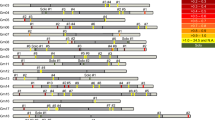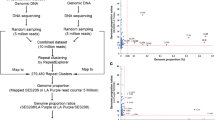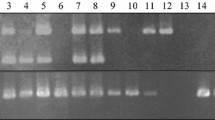Abstract
The Tpv2 family of transposable elements of common bean, Phaseolus vulgaris, belongs to the Ty1/copia group of long terminal repeat (LTR) containing retrotransposons. By reverse transcriptase (RT)-PCR and by analysis of genomic clones, we characterized four of the approximately 40 copies present in the Phaseolus genome, and the genomic environment of their integration sites. Tpv2 integrated preferentially into actively transcribed regions. While none of the isolated elements had all the functional domains necessary for transposition, analysis of bean cultivars suggested that some members of the Tpv2 family transposed in recent breeding history. Probes derived from Tpv2, as well as flanking genomic sequences, may be useful for classifying Phaseolus cultivars.
Similar content being viewed by others
References
Altschul SF, Madden TL, Schäffer AA, Zhang J, Zhang Z, Miller W, Lipman DJ: Gapped BLAST and PSI-BLAST: a new generation of protein database search programs. Nucl Acids Res 25: 3389–3402(1997).
Ausubel FM, Brent R, Kingston RF, Moore DO, Seidman JG, Smith JA, Struhl K: Current Protocols in Molecular Biology. John Wiley, New York (1987).
Biessmann H, Valgeirsdottir K, Lofsky A, Chin C, Ginther B, Levis RW, Pardue, ML: Addition of telomere-associated HeT DNA sequences 'heals' broken chromosome ends in Drosophila. Cell 61: 663–673(1990).
Boeke JD, Stoye JP: Retrotransposons, endogenous retroviruses, and the evolution. In: Coffin JM, Hughes SH, Varmus HE (eds) Retroviruses, pp. 343–435. Cold Spring Harbor Laboratory Press, Plainview, NY (1997).
Chaboissier M-C, Bornecque C, Busseau I, Bucheton A: A genetically tagged, defective I element can be complemented by actively transposing I factors in the germline of I-R dysgenic females in Drosophila melanogaster. Mol Gen Genet 248: 434–438(1995).
Curcio JM, Morse RH: Tying together integration and chromatin. Trends Genet 12: 436–438(1996).
Devine SE, Boeke JD: Integration of the yeast retrotransposon Ty1 is targeted to regions upstream of genes transcribed by RNA polymerase III. Genes Devel 10: 620–633(1996).
Dhellin O, Maestre J, Heidmann T: Functional differences between the human LINE retrotransposon and retroviral reverse transcriptases for in vivo mRNA reverse transcription. EMBO J 16: 6590–6602(1997).
Grandbastien M-A: Activation of plant retrotransposons under stress conditions. Trends Plant Sci 3: 181–187(1998).
Hammond-Kosack KE, Jones JDG: Plant disease resistance genes. Annu Rev Plant Physiol Plant Mol Biol 48: 575–607 (1997).
Hirochika H: Activation of tobacco retrotransposons during tissue culture.EMBO J 12: 2521–2528(1993).
Hirochika H, Fukuchi A, Kikuchi F: Retrotransposon families in rice. Mol Gen Genet 233: 209–216(1992).
Hirochika H, Sugimoto K, Otsuki Y, Tsugawa H, Kanda M: Retrotransposons of rice are involved in mutations induced by tissue culture. Proc Natl Acad Sci USA 93: 7783–7788(1996).
Kami J, Gepts P: Phaseolin nucleotide sequence diversity in Phaseolus. I. Intraspecific diversity in Phaseolus vulgaris. Genome 37: 751–757(1994).
Katz RA, Skalka AM: The retroviral enzymes. Annu Rev Biochem 63: 133–173(1994).
King EO, Wood MK, Raney DE: Two simple media for the demonstration of pyocyanin and fluorescein. J Lab Clin Med 44: 301–307(1954).
Kirchner J, Connolly CM, Sandmeyer SB: Requirement of RNA Polymerase III transcription factors for in vitro positionspecific integration of a retroviruslike element. Science 267: 1488–1491(1995).
Kunze R, Saedler H, Lönnig W-E: Plant transposable elements. Adv Bot Res 27: 332–470(1997).
Levis RW, Ganesan R, Houtchens LA, Tolar LA, Sheen FM: Tansposons in place of telomeric repeats at a Drosophila telomere. Cell 75: 1083–1093(1993).
Mhiri,C, Morel J-B, Vernhettes S, Casacuberta JM. Lucas H, Grandbastien M-A: The promoter of the tobacco Tnt1 retrotransposon is induced by wounding and by abiotic stress. Plant Mol Biol 33: 257–266(1996).
Parniske M, Hammond-Kosack KE, Golstein C, Thomas CM, Jones DA, Harrison K, Wulff BBH, Jones JDG: Novel disease resistance specificities result from sequence exchange between tandemly repeated genes at the Cf-4/9 locus of tomato. Cell 91: 821–832(1997).
Preston BD: Error-prone retrotransposition: Rime of the ancient mutators. Proc Natl Acad Sci USA 93: 7427–7431 (1996).
Sambrook J, Fritsch FF, Maniatis T: Molecular Cloning: A Laboratory Manual. Cold Spring Harbor Laboratory Press, Cold Spring Harbor, NY (1989).
Smyth DR: Plant retrotransposons. In: Verma DPS (ed) Control of Plant Gene Expression, pp. 1–15. CRC Press, Boca Raton, FL (1993).
Suoniemi A, Anamthawat-Jó nsson K, Arna T, Schulman AH: Retrotransposon BARE-1 is a major, dispersed component of the barley (Hordeum vulgare L.) genome. Plant Mol Biol 30: 1321–1329(1996).
Tohme J, Gonzalez OD, Beebe S, Duque MC: AFLP analysis of gene pools of a wild bean core collection. Crop Sci 36: 1375–1384(1996).
Wanzenböck E-M, Schöfer C, Schweizer D, Bachmair A: Ribosomal transcription units integrated via T-DNA transformation associate with the nucleolus and do not require upstream repeat sequences for activity in Arabidopsis thaliana. Plant J 11: 1007–1016(1997).
Wessler SR: Plant retrotransposons: turned on by stress. Curr Biol 6: 959–961(1996).
Wessler SR, Bureau TE, White SE: LTR-retrotransposons and MITEs: Important players in the evolution of plant genomes. Curr Opin Genet Dev 5: 814–821(1995).
Zhou S, Ke N, Kim JM, Voytas DF: The Saccharomyces cerevisiae retrotransposon Ty5 integrates preferentially into regions of silent chromatin at the telomeres and mating loci. Genes Dev 10: 634–645(1996).
Author information
Authors and Affiliations
Rights and permissions
About this article
Cite this article
Garber, K., Bilic, I., Pusch, O. et al. The Tpv2 family of retrotransposons of Phaseolus vulgaris: structure, integration characteristics, and use for genotype classification. Plant Mol Biol 39, 797–807 (1999). https://doi.org/10.1023/A:1006132532684
Issue Date:
DOI: https://doi.org/10.1023/A:1006132532684




